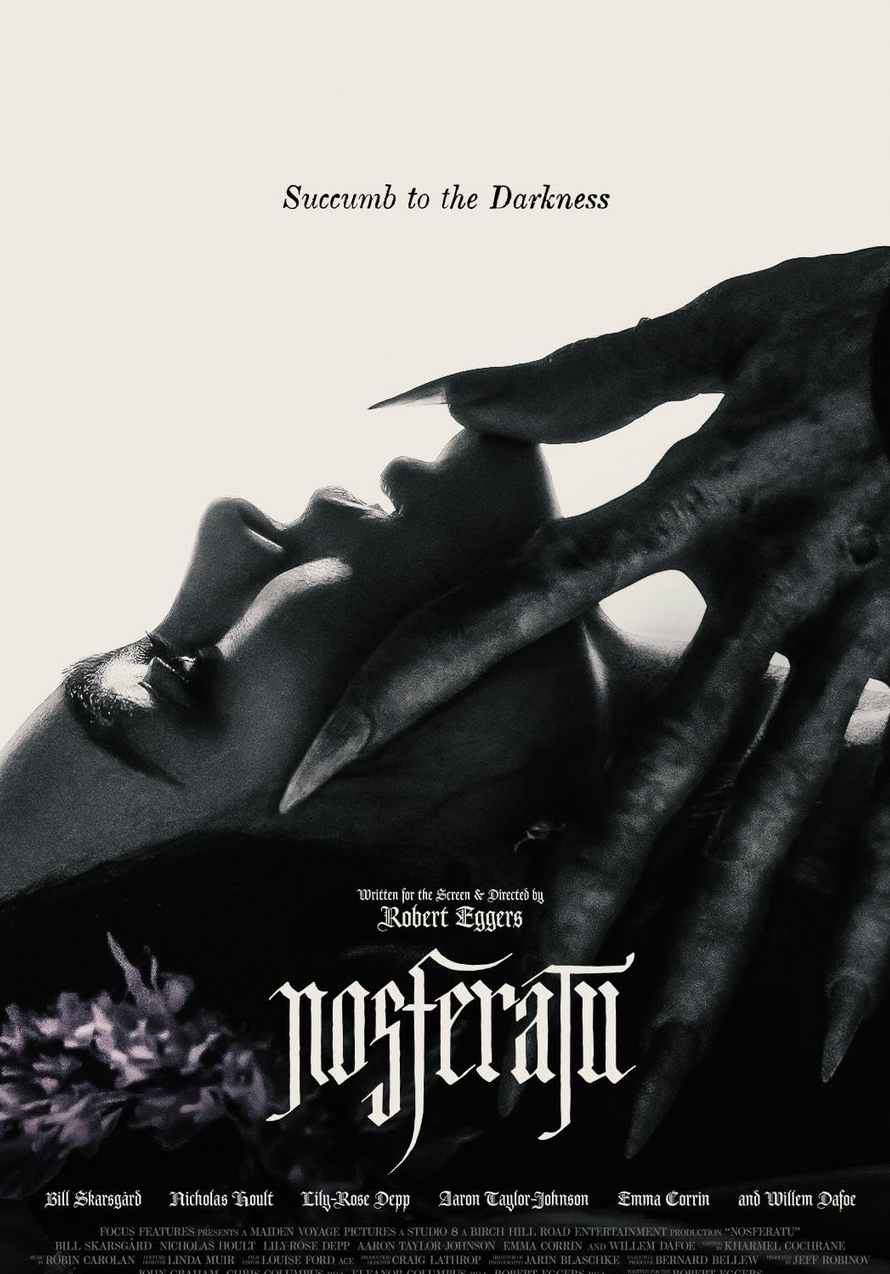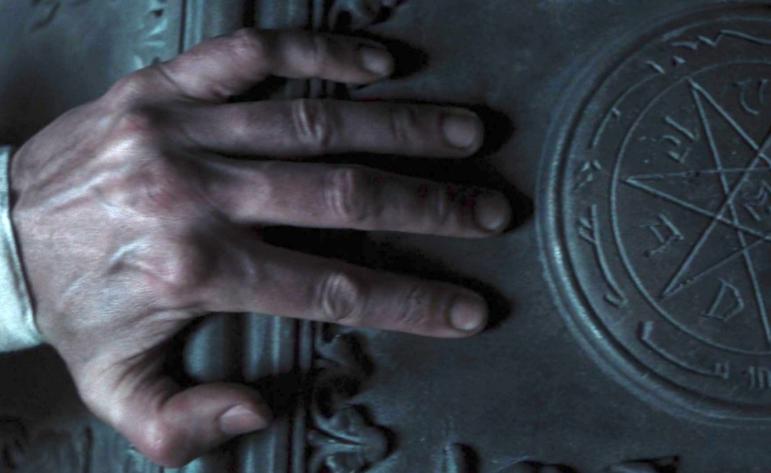
“I fear we may keep close here to a number of superstitions which may seem backward to a man of your higher learning. It is their filthy ritual.” —Count Orlok, Nosferatu (2024)
Every vampire story is about magic, but Robert Egger’s Nosferatu is more open about this than its predecessors. A remake of 1922’s Nosferatu: A Symphony of Horror, the silent German expressionist film by F.W. Murnau, this 2024 retelling is a copy of a copy. Murnau’s film was a German rip-off of Bram Stoker’s Dracula, a crime for which Stoker’s widow was able to sue. However, neither Stoker nor Murnau dealt directly with the question of what force animates a corpse. Both of these earlier tellings focus on the fear of invasion, of foreigners, of disease and the end of feudalism.
With its right hand Eggers’s Nosferatu points at all the sex it can, but its left invokes the imagery and the uncanny nature of folk magic.

Theatrical release poster for Nosferatu (2024) [Focus Features]
Thomas Hutter (Nicholas Hoult), a mild-mannered young solicitor, is newly married and sent out on assignment to settle a real estate deal by his employer, Herr Knock (Simon McBurney). Upon this first introduction, there are hints to the audience that something occult is in play. The Transylvanian Count Orlok (Bill Skårsgard) seals his correspondences not with any recognizable regional heraldic symbols, but with a spindly heptagram inscribed with indecipherable lettering, encircled by a double ouroboros. The camera pans slowly over these symbols; we are meant to see them.
The people of the village below Orlok’s castle warn Hutter immediately that the company he seeks is unholy, spitting three times when they hear Orlok’s name and warning him in Romanian and sometimes Romani to avoid falling beneath their lord’s shadow. They set wards about their inn and space, working sigils on their windows while wielding the genre’s ubiquitous allium, chanting “I banish you with garlic.”
Hutter awakens in his rented bed with a primitive talisman tied around his neck. Unaware of what it might mean, he tears it from his body as he awakens from a half-remembered midnight experience when he witnessed the locals leading a naked virgin on horseback to the gravesite of a vampire and impaling the latter with a cold iron rod. When Hutter musters the courage to ask Orlok about these rites, they are dismissed as country paganism by the man who seals his letters with red wax and hermeticism.
Seeking to flee the castle after the bloodsucker has fed upon him, Hutter sees these symbols again on the coffin where Orlok sleeps. When the young man finally manages to escape by jumping into the river, he is offered the one defense the people of Orlok’s land know will work: folk magic. The same people who ward their doors with garlic surround the young German man with more of the same: talismans and chants, this time syncretized with Christian prayers. They give away the wisdom Hutter will need to survive: that the vampire cannot enter a consecrated house of the Christian god, and that he must return to the earth in which he was buried.
They also describe Orlok’s past in more detail than any other version of this story: “A black enchanter he was in life,” a robed figure explains through a translator. They refer to Orlok as “Solomonari,” a wizard of Romanian folklore, said to ride on dragons, according to Andrei Oișteanu, ethnologist and anthropologist, in Cosmos Vs. Chaos: Myth and Magic in Romanian Traditional Culture: a Comparative Approach.
Orlok’s opposite number, Dr. Albin Eberhart von Franz (Willem Defoe), is also open about his magical doings, in a departure from his progenitor, Van Helsing, who uses Catholic prayer in Dracula as a means to repel his foe. Von Franz is introduced as being obsessed with Paracelsus, Agrippa, alchemy and magic, by those who know him well. His first lines of dialogue are concerned with Mysteriorum Libri Quinque, the hermeticist magician John Dee’s five books of magic, originally published in the 1580s.
Von Franz is a fascinating figure in this film, representing not the intervention of a Christian morality or cosmology, but instead a credulous and worldly point of view on how this monster may be subdued. The amoral magician does not tell Frau Ellen Hutter (Lily-Rose Depp) to preserve her marital chastity in duty to her god, but to submit sexually to Orlok, adding that “in heathen times, you might have been a priestess of Isis.”
These factors combine to create a world altogether richer than that of Stoker’s imagination, which was expansive enough to borrow from Romanian folklore a creature that might exist outside of the Christian creation myth, but not to realize that if one specific kind of magic is real and made flesh that others might be, too. Nosferatu (2024) describes itself diegetically as a “morbid fairy tale,” one where magic is real and the rules of redemption come from many books instead of one.

A detail of an occult symbol in Nosferatu (2024) [Focus Features; this image has been brightened to show detail]
“God is beyond our morals,” Von Franz muses as the plague takes the German port town of Wisberg and a young man weighs the terror of trading his new wife for countless innocent lives. This enigmatic sentence encompasses the entire film’s statement on right and wrong with respect to Count Orlok, eater of men. Morality is eschewed as a tool for children and lesser beings. Those who understand what wonders and terrors the world may hold, the folk magicians and Solomonari, the hermeticists and vampires, the young woman who has made contact with something truly Other on a spiritual plane – these must operate beyond the reach of any simple morality.
This unusual point of view, coupled with these pointed inclusions and explicit uses of magic, make this new Nosferatu a surprisingly Pagan entry to what has long been a Christian collection of tales of the vampire.
Nosferatu is streaming on AppleTV, as well as other places.
Editor’s note: An earlier version of this story incorrectly identified the director of the film. We regret the error.
The Wild Hunt is not responsible for links to external content.
To join a conversation on this post:
Visit our The Wild Hunt subreddit! Point your favorite browser to https://www.reddit.com/r/The_Wild_Hunt_News/, then click “JOIN”. Make sure to click the bell, too, to be notified of new articles posted to our subreddit.